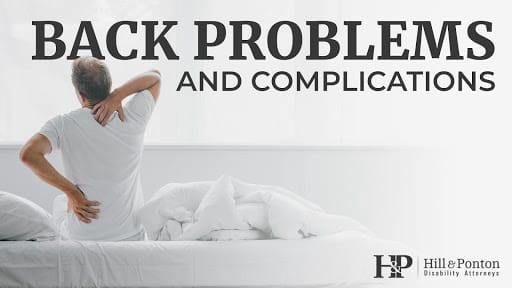If you’re a veteran experiencing chronic back pain, you might be eligible to claim additional disabilities related to your back condition. Claiming these secondary conditions can increase your overall VA disability rating and compensation. Below, we’ll explore some of the most common conditions secondary to back injuries or back pain.
Neurological Conditions
Radiculopathy
Radiculopathy is one of the most frequent neurological disorders veterans experience secondary to lower back pain. It occurs when spinal nerve roots become compressed due to conditions like:
- Herniated discs
- Degenerative disc disease
- Spinal stenosis (narrowing of the spinal canal)
A common form, sciatica, specifically involves irritation of the sciatic nerve, causing sharp pain that travels from the lower back down through the buttock and leg. Veterans may receive separate ratings from the VA for radiculopathy if clear evidence shows these conditions directly result from their lower back disability.
Myelopathy
Spinal myelopathy is a broad term used to describe any neurological deficit related to the spinal cord due to compression, inflammation, or other damage. Causes of myelopathy include:
- Spinal stenosis
- Degenerative disc disease
- Trauma (such as fractures)
- Tumors or infections (less commonly)
Musculoskeletal Conditions
Musculoskeletal conditions are common secondary issues linked to lower back pain, which changes how you move, stand, and perform daily activities. Over time, these adjustments put stress on other joints and muscles, potentially leading to new injuries or chronic pain in different areas of the body.
Hip Joint Issues
If you have lower back pain, you may start walking differently to relieve discomfort. This abnormal gait, or way of walking, can strain the hip joints and surrounding areas, causing issues such as:
- Trochanteric bursitis (inflammation around the hip)
- Hip strain or arthritis
- Labral tears (damage to cartilage inside the hip joint, developing gradually over time)
These conditions can receive a secondary VA rating if clearly connected to your lower back disability. Learn more about hip ratings.
Knee Disabilities
Lower back pain frequently results in altered posture and uneven weight distribution, putting extra pressure on your knees. Veterans may experience:
- Patellofemoral pain syndrome (pain around or behind the kneecap; “runner’s knee”)
- Meniscal degeneration (damage to the cartilage cushion within the knee)
- Osteoarthritis (chronic joint inflammation)
If your knee problems are caused or worsened by your lower back condition, you can claim them as secondary conditions. See how to claim knee disabilities.
Ankle and Foot Disabilities
Lower back pain can also impact your ankles and feet. The VA may rate the following conditions separately, providing additional compensation when they result from lower back problems:
- Plantar fasciitis (heel pain from inflammation)
- Achilles tendinitis (painful inflammation of the Achilles tendon)
- Ankle instability or strain
Shoulder Strain
Altered thoracic posture or the use of assistive devices like canes or crutches due to lower back pain can both strain shoulders. Common shoulder conditions secondary to middle or lower back pain include:
- Rotator cuff tendinopathy (inflammation or degeneration of shoulder tendons)
- Shoulder impingement syndrome (pinched tendons or bursa in the shoulder)
- Frozen shoulder (adhesive capsulitis, characterized by stiffness and pain)
Neck Pain (Cervical Strain)
Lower back pain can disrupt normal posture, straining the neck muscles. Middle back pain also causes you to rely heavily on your upper back and neck muscles, which may lead to chronic muscular strain. Conditions such as myofascial pain syndrome or regional strain patterns could potentially be claimed as secondary to your back issues.
Bladder and Bowel Impairments
Veterans with lower back pain might develop bladder or bowel impairments, especially if nerve roots or the spinal cord in the lumbar or sacral region are affected. Bladder and bowel functions are regulated by nerves from the sacral region (specifically segments S2–S4). When a lower back disability involves these nerves, it can lead to difficulty controlling urination or bowel movements. Qualifying back conditions include:
- Herniated discs
- Spinal stenosis
- Cauda equina syndrome (a severe compression of nerve roots in the lower spine)
- Spinal cord compression
The VA often provides separate disability ratings for these impairments if linked to your primary lower back disability. In some cases, urinary incontinence or bowel impairment may qualify veterans for Special Monthly Compensation, providing additional benefits.
Sexual Dysfunction
Lower back injuries frequently impact sexual health, particularly when they involve the lumbar spine (vertebrae L1–L5) or sacral nerves (S2–S4). This is because nerves in these regions directly control sexual functions. Veterans might experience:
- Erectile dysfunction (ED) for male veterans
- Female sexual arousal disorder (FSAD) for female veterans
Sexual dysfunction can also be aggravated by chronic pain, the use of medications like opioids for managing lower back pain, or related mental health conditions such as depression or anxiety.
Additionally, veterans with significant sexual dysfunction may qualify for Special Monthly Compensation, specifically SMC-K which provides extra compensation for loss of use of a reproductive organ.
Psychological Secondary Conditions
Veterans experiencing back pain often deal with emotional and psychological challenges due to prolonged discomfort and physical limitations. The VA recognizes several common mental health conditions as secondary to chronic back pain, including:
- Depression: Chronic pain and restricted activities can lead to feelings of sadness, hopelessness, or loss of enjoyment in life.
- Anxiety Disorders: Persistent pain might cause anxiety about activities that could trigger or worsen discomfort, limiting your everyday activities.
- Sleep Disorders: Continuous lower back pain frequently interrupts sleep, resulting in insomnia or poor-quality rest, further aggravating mental and physical health.
Other Secondary Conditions to Back Pain
Veterans dealing with thoracic or lower back pain may also encounter other secondary conditions, due to lifestyle changes or side effects from long-term treatments used to manage chronic back pain.
Obesity and Obesity-Related Conditions
Chronic lower back pain frequently limits physical activity, which in turn often leads to weight gain, increasing the risk for other serious health conditions. If obesity is clearly shown as a result of your service-connected lower back pain, related health conditions could also be service-connected. Common obesity-related conditions include:
- Diabetes
- High blood pressure
- Sleep apnea
- Heart disease
These secondary conditions can qualify for VA compensation if documented evidence establishes obesity as a direct intermediate step between your lower back disability and these additional medical issues. Learn more about sleep apnea secondary to back pain.
Medication-Related Secondary Issues
Long-term treatment for back pain often involves medications that have adverse effects. Secondary conditions related to medication use may include:
- Cognitive effects: Difficulty with concentration, memory issues, or general cognitive impairment caused by opioids and muscle relaxants.
- Gastrointestinal problems: Stomach pain, ulcers, or gastrointestinal bleeding resulting from prolonged use of NSAIDs such as ibuprofen.
- General side effects: Fatigue, dizziness, nausea, or other complications associated with continuous medication use.
VA Benefits for Secondary Conditions to Back Disabilities
When veterans develop secondary conditions related to their service-connected back condition, they may be eligible for a higher VA disability rating. Depending on how severe the conditions are, veterans might also qualify for Total Disability based on Individual Unemployability or Special Monthly Compensation.
How to Claim VA Disability
Establishing Service Connection
To successfully claim secondary conditions, veterans must clearly show the VA how their back pain or back condition directly caused or worsened these other health issues. You will need a current diagnosis and proof of a connection between the primary service-connected back condition and the new secondary disability.
Documentation and Evidence Requirements
- Medical records clearly diagnosing the disability
- Doctors’ notes specifically linking the secondary condition to your back disability
- A detailed personal statement explaining how your primary back condition led to or aggravated the secondary issue
- If possible, buddy statements from people who can support the claim
Overturning a Denial
If the VA denies your secondary claim initially, don’t lose hope. You have the right to appeal the decision. Typically, appealing involves providing additional evidence or getting an independent medical opinion linking your back pain to secondary conditions.
Hill & Ponton specializes in appealing VA claim denials and assisting veterans who need to increase their disability rating. Get your free evaluation today.
How to Get TDIU
Veterans with multiple secondary conditions connected to back disabilities who find it difficult to maintain steady employment may qualify for Total Disability based on Individual Unemployability. This benefit pays at the 100% disability rate, even if your combined ratings fall short of 100%. Learn more about TDIU eligibility.
Do You Qualify for Special Monthly Compensation?
Special Monthly Compensation provides higher compensation beyond the 100% rating for veterans whose disabilities significantly impair their quality of life or require ongoing assistance. For instance, if your back disability is causing lower back pain responsible for mobility issues, urinary incontinence or sexual dysfunction, you might qualify for extra compensation.
Find out more about SMC eligibility or call us to see how we can help. Our VA lawyers specialize in ensuring disabled veterans receive all the benefits they deserve.



